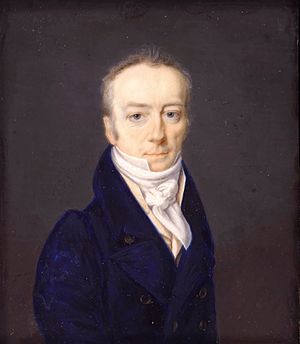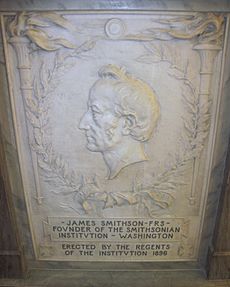James Smithson facts for kids
Quick facts for kids
James Smithson
|
|
|---|---|

James Smithson by Henri-Joseph Johns, 1816
|
|
| Born |
Jacques-Louis Macie
c. 1765 |
| Died | 27 June 1829 (aged 64) |
| Burial place | Smithsonian Castle, Washington, D.C. |
| Nationality | British |
| Alma mater | Pembroke College, Oxford |
| Occupation | Chemist, mineralogist |
| Known for | Founding donor of the Smithsonian Institution |
James Smithson (born around 1765 – died June 27, 1829) was a British chemist and mineralogist. He wrote many scientific papers for the Royal Society in the early 1800s. He also helped define a mineral called calamine, which was later named "smithsonite" after him.
Smithson is most famous for being the person who gave the money to start the Smithsonian Institution. This famous museum and research center in Washington, D.C., is also named after him.
He was born in Paris, France. His birth name was Jacques-Louis Macie. His parents were Elizabeth Hungerford Keate Macie and Hugh Percy, the 1st Duke of Northumberland. They were not married. His exact birth date and place are not known.
Soon after he was born, he became a British citizen. His name was changed to James Louis Macie. In 1800, after his mother died, he took his father's original last name, Smithson.
He went to Pembroke College, Oxford in 1782 and finished his studies in 1786. While at university, he went on a trip to Scotland to study rocks. He also studied chemistry and mineralogy. Smithson was known for his detailed scientific work. He traveled a lot around Europe and published about 27 scientific papers.
Smithson never got married and had no children. Because of this, he decided to leave his money to his nephew. But his will also said that if his nephew died without children, his money should be used to create an institution in Washington. This institution would be called the Smithsonian Institution. Its purpose would be "to increase and diffuse knowledge among men."
Smithson died in Genoa, Italy, on June 27, 1829, when he was 64 years old. Six years later, in 1835, his nephew died without any children. This meant Smithson's wish to create the Smithsonian Institution came true. He became the founder of this important place, even though he had never visited the United States.
Contents
James Smithson's Early Life

James Smithson was born around 1765. His mother was Elizabeth Hungerford Keate Macie. His father was Hugh Percy, 1st Duke of Northumberland. His mother was a wealthy widow.
Smithson was born in secret in Paris because his parents were not married. This is why his birth name was Jacques-Louis Macie. Later, it was changed to James Louis Macie. In 1801, when he was about 36, he changed his last name to Smithson. This was his biological father's original family name.
James grew up and became a citizen in England. He started studying at Pembroke College, Oxford in 1782. He earned his Master of Arts degree in 1786.
Smithson loved to travel and lived in many places across Europe. In 1784, while still a student, he went on a trip to Scotland. He studied geology there with other scientists. He was in Paris during the French Revolution.
In 1807, Smithson was captured during the Napoleonic Wars. He was held as a prisoner of war in Tönning and then in Hamburg. He wrote to Sir Joseph Banks, a famous scientist, asking for help. Banks helped him get released, and Smithson returned to England.
Smithson's Scientific Discoveries

Smithson's scientific work covered many different topics. He studied everything from how to make coffee to how to use calamine. Calamine is a mineral that was later named smithsonite in his honor. He also studied the chemistry of human tears and snake venom.
Smithson published 27 scientific papers during his life. He became a member of the Royal Society of London in 1787. This was a great honor. He worked and socialized with other important scientists like Joseph Priestley and Antoine Lavoisier.
His first paper was about a substance called "Tabasheer." This substance is used in traditional Indian medicine. It comes from inside bamboo plants.
In 1802, he presented his second paper, "A Chemical Analysis of Some Calamines." This paper was published under his new name, James Smithson. In it, he showed that calamine was a "true mineral." Before his work, people thought it was just a type of zinc oxide.
He also explored Kirkdale Cave. His findings, published in 1824, helped to change old ideas. People used to believe that the fossils in the cave were from a great flood. Smithson's work showed a different story.
Smithson is also known for being the first to use the word "silicates."
Later Life and His Will
Smithson died in Genoa, Italy, on June 27, 1829. He was buried in a Protestant cemetery there. In his will, written in 1826, Smithson left his money to his nephew, Henry James Dickenson. His nephew had to change his last name to Hungerford to receive the money.
Smithson's will also had a very important condition. It said that if his nephew died without any children, then all his money would go to the United States. This money would be used to create an educational institution in Washington, D.C. It would be called the Smithsonian Institution.
Henry Hungerford, Smithson's nephew, died on June 5, 1835. He was unmarried and had no children. This meant that the United States would receive Smithson's fortune. In his will, Smithson clearly explained the Smithsonian's purpose:
I then give all my property to the United States of America. It is to start an Establishment in Washington, called the Smithsonian Institution. Its goal is to increase and spread knowledge among people.
The Smithsonian Institution: Smithson's Legacy
After Smithson's death, the U.S. government learned about his gift. President Andrew Jackson told Congress about it. After much discussion, the Smithsonian Institution was officially created by law.
In 1836, President Jackson sent Richard Rush to England. His job was to get the money from Smithson's will. In 1838, Rush succeeded. He returned with 104,960 gold coins in eleven crates. He also brought Smithson's personal items, scientific notes, minerals, and books. The gold was turned into over $500,000.
On February 24, 1847, the Board of Regents, who oversaw the Smithsonian's creation, approved its official seal. This seal was designed by Robert Dale Owen.
Sadly, most of Smithson's papers and mineral collection were destroyed in a fire in 1865. However, his collection of 213 books is still safe at the Smithsonian. A portrait of Smithson as an Oxford student is now on display at the Smithsonian Castle. Other items, like a miniature portrait and his original will, are kept in other Smithsonian museums.
Smithson wanted to be remembered. He once wrote:
The best blood of England flows in my veins... My name shall live in the memory of man when the titles of the Northumberlands and the Percys are extinct and forgotten.
Moving Smithson's Remains to Washington
James Smithson was first buried in Genoa, Italy. The Smithsonian Institution helped pay for the upkeep of his grave. In 1905, the cemetery where he was buried was going to be moved. This was because a nearby quarry needed to expand.
Alexander Graham Bell, a regent of the Smithsonian, suggested moving Smithson's remains. He thought they should be brought to the Smithsonian Institution Building. In 1903, Bell and his wife traveled to Genoa to dig up the body.
On January 7, 1904, a ship left Genoa with Smithson's remains. It arrived in Hoboken, New Jersey, on January 20. From there, the remains were taken by a Navy ship, the USS Dolphin (PG-24), to Washington, D.C.
On January 25, a ceremony was held in Washington. The United States Cavalry escorted the coffin to the Castle. Bell said that his mission was complete. He handed over "the remains of this great benefactor of the United States." The coffin was then placed in the Board of Regents' room. Some of Smithson's personal items were also on display there.
Smithson's Memorial at the Smithsonian
After Smithson's remains arrived, the Board of Regents asked Congress for money to build a memorial. Many artists and architects sent in their ideas. Some ideas were for very large tombs, even bigger than the Lincoln Memorial. Others suggested smaller monuments near the Smithsonian Castle.
Congress decided not to pay for the memorial. So, the Smithsonian had to fund it themselves. They chose a design by Gutzon Borglum. He suggested remodeling a room in the Smithsonian Castle to hold the memorial. It would have Corinthian columns and a vaulted ceiling.
Instead of the large tower room, a smaller room was chosen. This room was once a janitor's closet. It would house an Italian-style sarcophagus.
On December 8, 1904, the Italian crypt arrived from Italy in sixteen crates. It came on the same ship that carried Smithson's remains. The chapel was designed with marble laurel wreaths and a neo-classical style.
Smithson was buried there on March 6, 1905. His casket was placed in the ground beneath the crypt. This chapel was meant to be a temporary resting place. However, Congress never approved a larger memorial. So, Smithson's remains are still there today.
See also
 In Spanish: James Smithson para niños
In Spanish: James Smithson para niños



